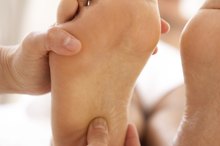What does fact checked mean?
At Healthfully, we strive to deliver objective content that is accurate and up-to-date. Our team periodically reviews articles in order to ensure content quality. The sources cited below consist of evidence from peer-reviewed journals, prominent medical organizations, academic associations, and government data.
The information contained on this site is for informational purposes only, and should not be used as a substitute for the advice of a professional health care provider. Please check with the appropriate physician regarding health questions and concerns. Although we strive to deliver accurate and up-to-date information, no guarantee to that effect is made.
Pins & Needles Sensation in Legs
Many people experience a sensation in their legs called "pins and needles." Those who hear the term and are familiar with the sensation may realize that the condition has something to do with nerves and/or circulation. As it turns out, there are several causes of the odd phenomenon of pins and needles in the legs 1.
If you are experiencing serious medical symptoms, seek emergency treatment immediately.
Features
What is commonly referred to as the "pins and needles" sensation is clinically referred to as paraesthesia 1. The most common description is a tingling, pricking sensation that can range from mild and annoying to downright painful. Often, these pricking sensations are accompanied by a feeling of numbness or heaviness. Because of this, the affected area is sometimes referred to as "asleep."
- What is commonly referred to as the "pins and needles" sensation is clinically referred to as paraesthesia 1.
- Often, these pricking sensations are accompanied by a feeling of numbness or heaviness.
Common Causes
What Are the Causes of Burning Sensations in the Inner Thigh?
Learn More
Most people have experienced the pins and needles sensation at some time in their lives 1. The main culprit behind the sensation is pressure exerted on the nerves in the body. For example: When a person sits cross-legged (or some variation of this position) for an extended amount of time, paraesthesia often occurs because excess weight is placed on nerves in the legs. When the legs are stretched out, the numbness is replaced by the pricking sensations, which is actually resumed communication between the nerves and the spinal column. This sensation can also be felt when blood circulation to the area is compromised. Again, this is usually remedied by altering position.
- Most people have experienced the pins and needles sensation at some time in their lives 1 for an extended amount of time, paraesthesia often occurs because excess weight is placed on nerves in the legs.
- This sensation can also be felt when blood circulation to the area is compromised.
Warning
It is quite common to have an occasional bout of paraesthesia. However, it should not be ignored when it occurs frequently or persistently. Chronic pins and needles can sometimes be indicative of nerve damage or the progression of a neurological disorder 1. Because treatment is determined by the underlying cause, it is extremely important to seek the advice of physician when frequent bouts of pins and needles occur in the legs 1.
Sciatica
Causes of Tingling & Burning Sensation in the Legs & Arms
Learn More
Sciatica is a condition that results from irritation of the sciatic nerves. These nerves, the largest in the body, are located in the lower back and extend down the entire length of the legs. Common sources of irritation are herniated discs, spinal stenosis and bone conditions such as osteoporosis. Regardless of the source, sciatica can cause severe paraesthesia in the legs, which can be very painful. Treatments for sciatica may include at-home physical therapy exercises, pain medications and surgery, depending on the source of sciatic irritation.
- Sciatica is a condition that results from irritation of the sciatic nerves.
- Regardless of the source, sciatica can cause severe paraesthesia in the legs, which can be very painful.
Toxic Substances
Sometimes the pins and needles sensation in the legs is indicative of chemically induced nerve damage 1. Occasionally, this nerve damage can result from certain prescription medications. More often, however, it is the result of toxins such as lead and mercury. Excessive consumption of alcohol over a prolonged period of time is known to cause damage to the nervous system. Alcohol-induced nerve damage is known as peripheral neuropathy.
- Sometimes the pins and needles sensation in the legs is indicative of chemically induced nerve damage 1.
- Occasionally, this nerve damage can result from certain prescription medications.
Effects
In non-serious cases, pins and needles is no more than an irritating occurrence that goes away on its own 1. In the case of neurological disorders and nerve damage, the long-term effects on the legs and the nervous system depend greatly upon the specific disorder and the prescribed course of treatment. As with most medical conditions, the best results stem from problems that are caught early. This is why it is important to discuss pins and needles with a doctor should the problem become persistent 1.
Related Articles
References
Writer Bio
Heather Clark is a professional writer with a bachelor's degree in communications from Austin Peay State University, where she was a features writer for the "AllState" campus newspaper. In addition to being a contributor for various websites, she is also a full-time staff writer/photographer for the "Courier," the U.S. Army news publication for Fort Campbell, Ky.









